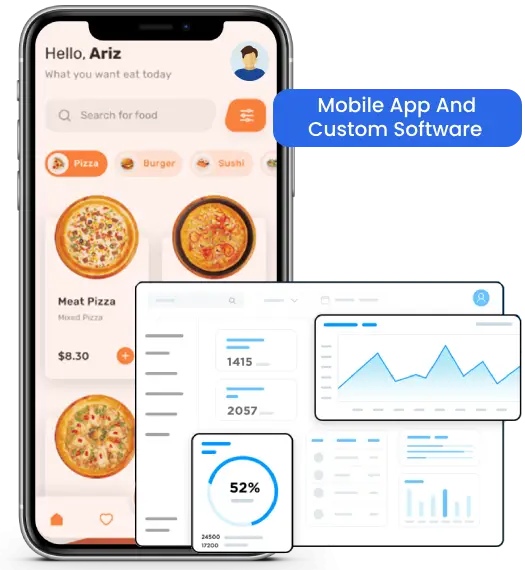Data visualization is a buzzword that has become immensely popular in the past few years due to its ability to help businesses make data-driven decisions. Data visualization tool is popularly used for drawing reasonable conclusions, creating information-rich presentations, and sharing discoveries from massive data sets that could help businesses and companies propel towards growth. The concept of data visualization goes beyond the traditional graphs and pie charts, it includes scatter plots, heat maps, bubble clouds, Venn diagrams and more making it an appropriate choice for understanding complex data sets. In this article, we will explore data visualization and highlight its advantages for businesses aiming to use it for improved decision-making and growth.
Data Visualization in a Nutshell
Data visualization is the process of creating visual representations of data in order to communicate information effectively. It involves the use of charts, graphs, maps, and other visual elements to represent data in a way that is easy to understand and interpret. Data visualization is an important tool for data analysis, as it allows you to identify trends, patterns, and relationships in your data that may not be immediately apparent from raw numerical values.
Data visualization can be used in a wide range of fields, including business, science, education, and journalism. It is an important part of data analysis and decision-making, as it allows you to communicate complex information concisely.
The main goals of data visualization are to:
- Communicate information effectively: Data visualization tool helps to communicate complex data concisely, making it easier for people to understand and interpret.
- Identify patterns and trends: Visualization can help to identify patterns and trends in data that may not be immediately apparent from raw numerical values.
- Support decision-making: By presenting data in a visual format, data visualization can help people to make informed decisions based on the information presented.
- Facilitate communication: Data visualization can be a powerful tool for communicating data-driven insights to a wider audience, such as colleagues, stakeholders, or the public.
- Enhance understanding: Visualization can help to enhance understanding of complex data by making it more accessible and intuitive.
Advantages of Data Visualization Tool
Data visualization offers a range of benefits that can significantly enhance the understanding and communication of data. Here are some of the key advantages:

Improved Understanding of Data
- Simplifies Complex Data: Large datasets with complex structures can be difficult to understand in raw form. Visualization tools turn numbers into intuitive charts, graphs, and infographics, making it easier to identify patterns, trends, and insights.
- Reveals Patterns and Trends: Visualizations help to quickly spot trends, outliers, or correlations that might be missed in textual or tabular data. This allows users to make faster, more informed decisions.
Enhanced Communication
- Storytelling with Data: Visualization helps tell a compelling story by presenting data in a way that highlights key messages, making it easier to communicate findings to stakeholders, especially those without technical expertise.
- Cross-Disciplinary Collaboration: Visual data can be understood across different departments, helping teams from marketing, finance, engineering, etc., to collaborate more effectively on data-driven initiatives.
Better Retention and Engagement
- Visual Memory: People are generally better at remembering visual content than text. Engaging, well-designed visuals increase the likelihood that the audience will retain the information presented.
- Increased Engagement: Interactive dashboards and visualizations allow users to explore the data on their own terms, increasing engagement and interest in the subject matter.
Improved Data Analysis and Exploration
- Data Exploration: Visualization tools allow users to dynamically interact with the data, helping them to drill down and explore different facets of the dataset without requiring complex statistical methods or queries.
- Identifying Relationships: Visual tools can help uncover relationships between variables that might not be immediately apparent in raw data or through basic statistical methods.
Increased Customer Insights
- Deep Understanding of Behavior: Visual analytics reveal patterns in customer interactions, purchases, and feedback, helping teams shape better strategies.
- Drives Personalization: Insights from visual data enable personalized experiences, which boost engagement and satisfaction.
Identifying Opportunities and Risks
- Spotting Early Trends: Visual data uncovers growth areas or potential challenges long before they become obvious through traditional analysis.
- Supports Proactive Planning: Teams can respond faster to shifts in the market, pricing, or operations based on real-time visual alerts.
Enhanced Analytical Capabilities
- Advanced Analytics Integration: Many data visualization tools integrate with machine learning algorithms, statistical analyses, and predictive models, allowing for deeper analysis and insights.
- Facilitates Big Data Analysis: With the increasing volume, velocity, and variety of data, visualization makes it easier to manage and analyze big data, revealing insights that may not be immediately evident through traditional methods.
Why Choose Dreamer Technoland to Enable Data-driven Insights?
At Dreamer Technoland, we understand that businesses have diverse needs when it comes to analyzing their operations and maximizing their return on investment. That’s why we offer customized data visualization services that are tailored to our clients’ specific requirements. Our platforms are designed to optimize production capacity and strengthen ROI channels, providing quick insights for informed decision-making.
Our data visualization services provide you with insights into your business trends and patterns by automatically collecting data from various sources and presenting it in an easy-to-understand format. This helps you to identify changes in customer behavior and predict future trends. With these insights, you can stay up to date on the latest activities and make informed decisions about your business.
Wrapping Up Everything
Data visualization plays a vital role in transforming complex datasets into clear, graphical formats that are easier to interpret. As data volumes continue to grow, raw numbers alone can overwhelm even the most experienced decision-makers. Visualization simplifies this complexity by highlighting trends, patterns, relationships, and outliers using charts, graphs, and maps. It supports deeper data exploration, helps identify opportunities and challenges, and enhances performance tracking. More importantly, it fosters better communication by making insights accessible to both technical and non-technical audiences, from stakeholders to customers. Whether used in business, science, or social research, data visualization turns information into actionable intelligence and supports smarter, faster decision-making.







